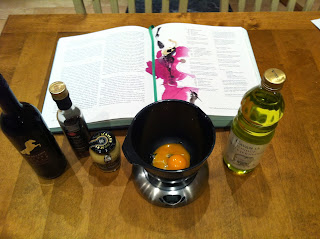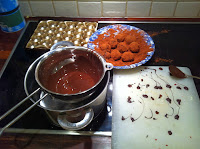I had read about this piece of culinary literature for some time and was suitably intrigued by what I read, but I really did not understand what it was. From what I gathered, it all revolved around something called modernist cuisine which I at that time did not know anything about other than that it probably was impossible to do by a mere mortal in a normal home kitchen. But as I have been a keen amateur chef most of my life, at times like to venture out into the unknown and also needed something substantial on my wish list for my 50th birthday, I officially wanted it. And I got it.
And, let it be known near and far, I love it, and for several reasons. First of all, I love well made books, almost regardless of the subject, and these books are well made. The binding is solid, the paper is of good quality and the whole thing comes in a plexiglass box. And they all have in-sewn satin bookmarks. I just love books with in-sewn satin bookmarks. The other thing you notice once you start flipping through the pages are the pictures. These books are a veritable art gallery.
The images are just gorgeously fantastic. Some are just inspirational, almost abstract images, others are highly instructional. The most famous of the images are those depicting equipment cut in half showing how they work. These are actually made by physically cutting things in half like a barbecue with meat on it. This is a fully working half barbecue complete with with half burgers and cole burning. The imagery is so good that they are now out in a book of their own. http://modernistcuisine.com/books/the-photography-of-modernist-cuisine/
But what about the actual contents? The first four of the five main volumes are divided into topics. These contain lots of theory about cooking mixed with lots of recipes. Volume five contain recipes for complete plated dishes. The last volume, the Kitchen Manual contains all recipes from the other volumes in a handy, ring bound volume made from splash proof paper that is practical in the kitchen.
So, what is this theory stuff? For any of you who has read Harold McGee's On Food and Cooking, these books are similar, but on steroids. And with more colour, both visually and language wise. In short, in addition to showing recipes, they explain how and why the different aspects of cooking work. As they say on the Modernist Cuisine web site: "The goal here is to break down recipes in such a way that you better understand not just the what (ingredients) and the how (methods), but also the why." And for someone like me who loves to explore how things work, this is the true value of these books. What happens when you boil something? Why does baking food in the oven work?
Volume 1, History and Fundamentals
This volume starts off with the history of cooking. This in itself is interesting, but it also places Modernist Cuisine in a broader scope. The largest portion of the volume is dedicated to microbiology, that is all the little creatures, bacteria etc that are in the food and how and why they can spoil the food. This is of course important stuff, especially for professional chefs, but I must admit that I found this chapter and the next where Food Safety is covered based on what we learned from the previous chapter a bit tedious for a keen amateur cook. But they are very important. The book then covers the fundamentals of heat and energy since most cooking is about treating ingredients with heat. The volume ends with a chapter that basically tells you what happens when water boils. And don't be fooled. You don't know, and it is actually quite interesting.Volume 2, Techniques and Equipment
To me, this volume was very interesting. The first chapter goes through most of the traditional techniques for cooking food and explains how they work and also how to get the most from them. How does a barbecue really work, and how do you find the sweet spot in your barbecue where the food gets the most from the heat? Do you know that baking is all about drying the food? And what we often call roasting (about cooking meat in the oven) actually is baking? This chapter contains a ton of interesting stuff about things that you do every day in the kitchen without really knowing what you were doing. It also shows why traditional techniques rely on tremendous skill and good luck to achieve perfect doneness.After this is a chapter that talks about modern ovens. I must admit that I skipped most of this as it mostly was about professional ovens that you find i restaurant kitchens and that I probably never will use.
Following this is an in-depth chapter on sous vide. Which I found most interesting. I have a sous vide setup, and this chapter gave me much needed knowledge about how to use optimise that and also gave me ideas of ways to use sous vide that I had not thought about earlier. The volume ends with an overview of equipment used in the modernist kitchen. Much of this will probably never find its way into the kitchens of most people. I skipped some of it, for instance the thorough coverage of the PacoJet, a machine that is too expensive for most home cooks.
Volume 3, Animals and Plants
This is where I am currently at, and I think the beginning of the meat section gives a good indication of what this entire set of books is all about.The meat section starts with how a muscle works when it is part of a live animal. It then goes through what happens when the animal dies and how that same muscle turns from muscle to meat, how it can be aged and how it should be cut to achieve best results. All along there are highly informative images showing the principles of what is going on. It is thorough, it is well presented and it gives me a ton of background material that may help me to understand why food is the way it is.
And all the way there are recipes giving examples of the techniques and theory. And these are always very detailed and easy to follow. Like how to make the perfect burger on the left here. Recipes are also scalable so it is easier to make a different number of portions than shown in the book.
All in all I feel that Modernist Cuisine is giving me all I need to become a better cook. I do not really know what they learn in culinary school, but I would guess that these volumes should give you most of what you need. What you do not get are the classical recipes since the recipes in the books all follow the modernist approach. But the theory and background are the same for classical and modernist cooking.











.jpg)

.JPG)







.JPG)

.jpg)































